Publication
Article
Psychiatric Times
Exploring the New Era of Hope and Possibilities for Patients With Dementia
Author(s):
"To be sure, we are still in the nascent stages of developing treatments. However, our armamentarium is steadily growing."
nathings_AdobeStock

SPECIAL REPORT: DEMENTIA
One of the benefits of having worked in a field for a long time is you gain perspective. That has certainly been the case for my clinical experiences in treating patients with dementia. Early on, the diagnosis was a challenge. Neurodegeneration starts early and progresses before any clinical signs are evident. The average patient with dementia is in the moderate stage before they receive a diagnosis.
In the past, it became important to identify earlier stages such as mild cognitive impairment. Today, we see discussions of prodromal phases prior to that. This change has resulted in the ability to recruit research participants for studies that will lead to meaningful treatments.
On a parallel path, the diagnostic technology has made considerable progress. CT scanning was useful in showing gross cerebral volume atrophy but was not particularly nuanced. MRI technology, particularly the more powerful 3T MRI, can show a great deal more.
We now regularly quantify hippocampal volumes as we delineate the degree of neurodegeneration in key parts of the brain. Functional MRI and PET scanning allow us to probe the brain in action and discover how its parts relate to each other. Biomarkers have been another burgeoning area of both diagnostic and functional significance.
Not surprisingly, treatment has evolved over time as well. Initial expectations with cholinesterase inhibitors were admittedly modest. We would point to such features as temporarily delaying the progression of the disease or delaying nursing home admission as markers of success.
To be sure, we are still in the nascent stages of developing treatments. However, our armamentarium is steadily growing. Various agents are proving successful in managing agitation with limited adverse events. Unique mechanisms of action are being considered that would have been difficult to imagine just a few years ago.
What’s more, neuro protection and disease-modifying treatments no longer seem as elusive as they once did. These new treatments are targeting the underlying pathophysiology of some dementias, the deposition of amyloid in the brain. We are moving from symptomatic treatments to disease-modifying treatments.
There are many creative and motivated individuals working in this space. Of course, the aging of our population demands nothing less. As we review the history of this field, we can see the benefits of tenacity in the face of overwhelming challenges. We can also see that consistent incremental changes have now brought us to a very exciting era of possibilities and hope for patients. I look forward to a time when we can begin to target prevention as well.
Dr Capote is medical director of the Division of Neuropsychiatry at Dent Neurologic Institute in Amherst, New York, and medical director of addiction services at BryLin Hospital in Buffalo, New York. He is also the Neuropsychiatry Section Editor for Psychiatric Times.TM







